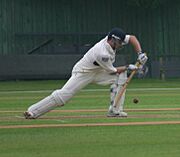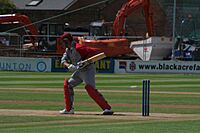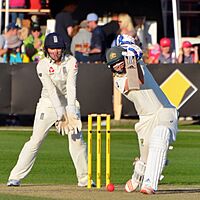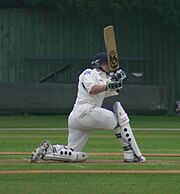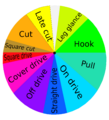Batting (cricket) facts for kids
In cricket, batting is the exciting skill of hitting the ball with a bat. The main goals are to score runs and to protect your wicket (the three stumps behind you). A player who is batting is called a batter. Top batters need quick reflexes, smart thinking, and great physical skills. They must adapt to different cricket pitches and conditions around the world.
During a team's turn to bat, called an innings, two batters are always on the field. The one who faces the bowler is the striker. The other is the non-striker. When a batter is out, a teammate replaces them. This continues until 10 players are out, or the innings ends in another way. Then, the other team gets their turn to bat.
Batting strategies change based on the game and situation. Batters want to score many runs quickly without getting out. These goals often clash! Hitting fast means taking risks, which could lead to getting out. Playing safely might mean not scoring any runs. Batters decide whether to play carefully to stay in, or hit hard to score fast. Unlike other bat-and-ball games, cricket batters can hit the ball in any direction.
Cricket keeps track of many stats, and batting stats are very important. A batter's batting average shows how effective they are. It's calculated by dividing their total runs by how many times they've been out.
Don Bradman is often called the greatest batter ever. He set many records in the 1930s and 1940s. His Test average of 99.94 runs is still unmatched! Sachin Tendulkar holds many modern records, including being the first to score 100 international centuries. Brian Lara holds the record for the highest score in a first-class match (501 not out). Mithali Raj is considered the greatest batter in women's cricket. She is the highest run-scorer in women's international cricket.
Contents
Understanding Batting Terms
Any player, whether they are a specialist batter or not, is called a "batter" when they are hitting the ball. The action of hitting the ball is called a "shot" or "stroke". A player picked mainly for their batting skill is called a specialist batter.
In 2021, the rules of cricket changed to officially use "batter". This makes the term gender neutral, meaning it works for everyone.
How Batters Play: Techniques and Shots
Over time, batters have developed a standard way of playing. This "technique" includes how they stand before the ball is bowled. It also covers how they move their hands, feet, head, and body to hit the ball. Good technique means getting into the right position quickly. This includes getting your head and body in line with the ball. Your feet should be placed near where the ball will bounce. Then, you swing the bat to hit the ball at the perfect moment.
The way a batter moves depends on the shot they want to play.
- Front-foot shots use your weight on your front foot. These are usually for balls pitched closer to you.
- Back-foot shots use your weight on your back foot. These are for balls pitched shorter.
Shots can also be called "vertical" or "straight-bat" shots. Here, the bat swings up and down (like a drive). Or they can be "horizontal" or "cross-bat" shots. Here, the bat swings sideways (like a pull shot).
Batters can hit the ball anywhere they want. But good technique has led to "standard" or "orthodox" shots. These are the "textbook" shots taught in coaching books.
However, limited overs cricket (like T20) needs fast scoring. This has led to more "unorthodox" shots. These shots aim to hit the ball into empty spaces where no fielders are. Unorthodox shots are usually riskier than orthodox ones.
Getting Ready: Stance and Backlift

The stance is how a batter stands to face the bowler. A good stance is comfortable, relaxed, and balanced. Your feet should be about 40 cm (16 inches) apart, parallel, and across the crease line. Your front shoulder should point down the pitch, and your head should face the bowler. Your weight should be balanced, and the bat should be near your back foot. Batters often crouch slightly. This helps them hit the ball more powerfully. Just before the bowler releases the ball, the batter lifts their bat. They also shift their weight onto the balls of their feet. This gets them ready to move quickly to hit the ball.
Most batters use the standard side-on stance. But some international players, like Shivnarine Chanderpaul and Steve Smith, use an "open" or "square on" stance.
Backlift is how a batter lifts their bat before hitting the ball. The bat should be lifted as straight up as possible. Coaching books often suggest the bat should be slightly angled. A common tip is to point the bat face towards first or second slip. Some players, like Brian Lara, use a very high backlift. Others, like Peter Willey, use a shorter backlift.
Moving to the Ball: Forward and Back
Batters move forward or backward to intercept the ball.
- A front foot shot means moving forward. This is for balls that arrive between ankle and thigh height. The batter steps forward and bends their front knee. This brings the bat down to the ball's height. Moving forward helps the batter hit the ball right after it bounces. This can stop dangerous sideways movement of the ball.
- A back foot shot means moving backward. This is for balls that arrive between thigh and head height. The batter steps back and might stand on their tiptoes to raise the bat. Stepping back gives the batter a little more time to react to unexpected ball movement or bounce.
Different Cricket Shots
Cricket shots are divided into two main types: vertical-bat and horizontal-bat.
Vertical-Bat Shots
Vertical-bat, or straight-bat, shots can be played off either the front or back foot. The bat is held vertically when it hits the ball. The batter's head is usually right above where the bat hits the ball. This helps them judge the ball's path accurately. The bat can be still (a block), angled (a glance), or swinging forward (a drive).
Defensive Shots
A block is a defensive shot. Its main purpose is to stop the ball from hitting the wicket or the batter's body. There isn't much power behind this shot. It's usually played with a light grip, just stopping the ball.
- A block played on the front foot is a forward defensive.
- A block played on the back foot is a backward defensive.
Sometimes, batters can gently push a block into an empty space to score a single run.
In Test cricket, batters often use blocks and "leaves". They don't need to score runs quickly, so they can choose which balls to play.
A leg glance is a gentle straight-bat shot. It's played when the ball is aimed slightly on the leg side (towards your body). The batter uses their bat and wrists to flick the ball as it passes. This sends the ball towards the square leg or fine leg area. The bat face is angled towards the leg side at the last moment.
The leave is when the batter doesn't try to hit the ball at all. They let it pass by. Batters often use the leave when they first start batting. This helps them understand the pitch and bowling. When leaving, the batter must watch the ball carefully. They need to make sure it won't hit them or the wicket. They also keep their bat and hands out of the way to avoid accidentally touching the ball and getting out. Batters only leave the ball if they are sure it won't hit the stumps.
Attacking Drives
A drive is a straight-bat shot. The batter swings the bat in a vertical arc, hitting the ball along the ground in front of them. It's a very common shot and often the first one taught. Drives are named by the direction the ball goes:
- Cover drive (towards the cover position)
- Off drive (towards mid-off)
- Straight drive (straight past the bowler)
- On drive (between the stumps and mid-on)
- Square drive (towards point)
Drives can be played off both the front and back foot. Most drives are hit along the ground to avoid being caught. But a batter might play a lofted drive to hit the ball over fielders, possibly for a six.
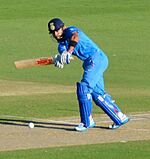
A flick shot is a straight-bat shot played on the leg side. The batter uses their wrists to flick a full-length ball. It's also called the "clip off the legs". The bat comes through straight, but the face is angled towards the leg side. It can be played off the front or back foot, from the toes or hips. The ball goes between the mid-on and square leg areas. Usually played along the ground, a flick can also be lofted over fielders.
Horizontal-Bat Shots
Horizontal-bat shots, also called cross-bat shots, include the cut, pull, hook, and sweep. These shots are riskier because it's harder to make good contact. So, they are usually played only when the ball isn't threatening the stumps (too wide or too short). The bat swings sideways, and the batter's head isn't always perfectly in line with the ball.
Cut Shot
A cut is a cross-bat shot played to a short ball, sending it wide on the off side. The batter hits the ball as it passes them, using the bowler's speed to guide it.
- A square cut goes towards point, almost 90 degrees from the wicket.
- A late cut is played as or after the ball passes the batter's body, going towards the third man position.
The cut is usually played off the back foot, but sometimes off the front foot against slower bowling. The bat face should roll over the ball to push it downwards. If timed badly with an open bat face, the ball can go up in the air, leading to a catch.
Square Drive
Despite its name, the square drive is a horizontal-bat shot, similar to the square cut. The difference is the ball's height when hit. A cut is for a ball bouncing waist-high or higher. A square drive is for a wide ball around shin height, with the batter bending low to hit it.
Pull and Hook
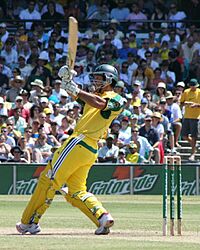
A pull is a cross-bat shot played to a ball bouncing around waist height. The batter swings the bat horizontally in front of their body, "pulling" the ball to the leg side. It goes towards mid-wicket or square leg. The term hook shot is used for balls bouncing at or above chest height. The batter "hooks" the ball around behind square leg, either along the ground or in the air. Pull and hook shots can be played off the front or back foot, but the back foot is more common.
Sweep Shot
A sweep is a cross-bat front foot shot played to a low ball, usually from a slow bowler. The batter kneels on one knee, brings their head in line with the ball, and swings the bat horizontally near the pitch. They "sweep" the ball around to the leg side, usually towards square leg or fine leg.
- A paddle sweep gently deflects the ball towards fine leg with a mostly still bat.
- A hard sweep shot is played towards square leg with a strong horizontal swing.
The sweep is usually for balls on the leg side. But batters can also sweep balls from outside the off stump to the leg side. Trying to sweep a full, straight ball aimed at the stumps is risky because of the chance of lbw (getting out by the ball hitting your leg instead of the wicket).
Unorthodox Shots
Batters can play any shot they want. So, there are many unusual, often risky, shots. limited overs cricket has made these shots more popular. They help hit the ball into empty spaces. Unorthodox shots are rarely used in first-class cricket because it's more important to stay in than to score off every ball.
Some unorthodox shots have become famous:
Reverse Sweep
A reverse sweep is a sweep shot played in the opposite direction. Instead of sweeping to the leg side, it goes to the off side, towards backward point or third man. The batter might even swap their hands on the bat. This shot confuses fielders because it reverses their positions. It's risky for the batter, increasing the chance of lbw or hitting the ball up in the air to a fielder.
Mushtaq Mohammad first played this shot regularly in the 1970s. Bob Woolmer helped make it well-known. A famous example of a reverse sweep going wrong was when Mike Gatting got out in the 1987 Cricket World Cup Final.
Slog and Slog Sweep
A slog is a powerful pull shot hit over mid-wicket, usually in the air for a six. It's called a slog when hit to a ball that wouldn't normally be pulled. It's sometimes called hitting the ball to "cow corner". This suggests the batter is just hitting hard without much technique. The slog can be effective because the batter puts all their power into the swing.
A slog sweep is a slog played from the kneeling position used for a sweep. Slog sweeps usually go over square-leg. It's mostly used against full balls from slow bowlers. This gives the batter time to get into the kneeling position.
Upper Cut
An upper cut is a shot played towards third man. It's usually hit when the ball is pitched outside the off stump with extra bounce. It's a dangerous shot that can easily lead to a catch if not played correctly. This shot is common in modern cricket, especially in Twenty20 games. Famous players who use the upper cut include Sachin Tendulkar and Virender Sehwag.
Switch Hit
A switch hit is when a batter changes their handedness (from right-handed to left-handed, or vice-versa) and body position while the bowler is running up. Since fielders can't move during the bowler's run-up, this shot catches the fielding team off guard. Kevin Pietersen first used this shot in 2006. David Warner and Glenn Maxwell also use it often.
The International Cricket Council (ICC) has said the switch hit is legal. It's a risky shot because the batter is less skilled with their non-dominant hand.
Scoop / Ramp
A scoop shot is played to short, straight balls that would normally be defended. The batter gets low on their front foot and aims to hit the ball directly behind the stumps, over the wicket-keeper.
This shot is risky but aims for a part of the field where there are usually no fielders. This is especially true in Twenty20 and One Day International cricket, where there are fewer outfielders. A version of the scoop, called the Dilscoop, was created by Tillakaratne Dilshan of Sri Lanka.
Helicopter Shot
The helicopter shot is a powerful shot hit with a wristy flick, using the bottom hand strongly. It gets its name because the bat circles overhead after the shot. It's an unusual and clever shot. When done well, it can score boundaries even against good yorkers (balls pitched very full), which are usually hard to hit for runs. MS Dhoni made this shot famous, using it regularly to score boundaries against full-length balls.
French Cut
The French cut is a shot where the ball hits the inside edge of the bat. This sends the ball between the batter and the stumps, towards the fine leg position. It's very hard to play on purpose and is usually a mistake. It's risky because the batter can easily hit the ball onto their own stumps, getting bowled out.
Batting Strategy
A batter's main goal is to score runs safely against each bowler. To do this, they must think about the bowler's plan, where the fielders are, the pitch conditions, and their own strengths and weaknesses. Their strategy will include ways to score runs with low risk. The success of this plan depends on how well it's thought out and how well the batter performs it. A key part of batting strategy is balancing how aggressive you are (trying to score) with the risk of getting out.
The best strategy depends on many things: how many wickets are left, the target score (if batting last), and how much risk increases with faster scoring. Strategies are very different in Test cricket, One Day International, and T20 cricket.
Test Cricket Batting
In Test cricket, the goal is usually to score as many runs as possible. Since there are no limits on overs, batters can take their time. Test matches usually have 90 overs bowled per day. The first batters, called "openers", are chosen for their strong technique and ability to defend their wicket. This is because the first hour or two of an innings often has good conditions for bowling. The ball might move more in the air or off the pitch.
The number 3 batter is also usually chosen for good technique. Their job is to keep one end of the batting stable if an opener gets out. The "middle order" usually has the team's most skilled batters. Batting is often easier in the middle of the day. If a team starts batting late in the day, they might send in a nightwatchman.
A nightwatchman is usually a lower-order player. They are good at defending dangerous balls and leaving safe ones. They don't aim to score many runs. This player protects the main batters from having to face the last few overs of the day or bat early the next morning. However, some teams don't use nightwatchmen.
In the third innings of a Test match, the batting team might score quickly. This is to set a big target for the other team. This usually happens on the fourth day. The captain decides how many overs they will give the other team to chase the runs. The captain usually declares their innings (ends it early) at a set time on the fourth day. This lets them bowl at least 20 overs that day and 90 overs on the last day. Bowling many overs to the other team in the fourth innings is important. This is because the pitch usually wears down on the fourth and fifth days. This makes conditions good for bowling, especially for slow bowlers. So, to make the target hard, the batting side scores runs faster until the captain declares.
If a team is far behind on runs on the fourth day, they might play defensively. Their goal is to avoid getting out. This helps them use up as much time as possible until the fifth day ends. If a team's innings doesn't end on the fifth day, the match is a draw (a tie). But if the batting team manages to get a big lead, the captain might declare. This lets them try to "force" a win on the final day.
One-Day International Cricket Batting
One Day International (ODI) matches have a limited number of overs. So, batters try to score runs quickly. They should aim for a higher run rate than what would just maximize their own score. It's good for batters to take risks of getting out, because another teammate can replace them. This higher risk strategy makes the most of the limited overs. Scoring quickly usually means trying to score at least one run per ball. Most batters score about four runs per over (four runs in six balls).
The right amount of risk changes based on different things. It should be higher if the team has many wickets left. This gives them a safety cushion. It should also be higher if the pitch is good for batting. This makes it easier to score without much risk. Risk should also increase towards the end of the innings when few overs are left. Research shows that teams generally follow these ideas. One exception is when batters are close to a personal milestone, like a century. They might take fewer risks to reach their milestone, even if it's not best for the team.
When a team bats, their best players bat first. The first three batters (numbers 1, 2, 3) are the top order. The next four (numbers 4, 5, 6, and sometimes 7) are the middle order. The last four (numbers 8, 9, 10, and 11) are the lower order or tail.
Specialist batters usually bat high up in the order to score more runs. The openers are the first two batters. They might not be the absolute best batters. But they are expected to handle the new ball and not get out until the ball loses its shine. A hard, shiny ball bounces and swings more, making it harder to face. Openers are also supposed to score runs quickly. This is because there are rules about where fielders can stand in the first 10 overs. This makes it easier to score boundaries. In ODIs, there are mandatory fielding restrictions for the first 10 overs. Then, there are two more 5-over periods, called power-play overs, that the captain can choose to use at any time.
After the openers comes the No. 3 or first-drop batter. Their job is to continue from the openers and usually play a careful, long innings. This brings stability to the batting. The team's best batter is usually at number 3 or 4. This protects them from the difficulties of facing the best bowlers on a fresh pitch. It also lets them play a long innings.
The middle order is often seen as the most important part of a batting lineup in ODIs. These players are responsible for building the team's score through the middle of the 50 overs. Middle-order batters often score many singles (one run) and 'twos'. They hit only occasional boundaries (fours or sixes). This is different from openers who score mostly in boundaries. The fielding restrictions are lifted in the middle overs, so fewer boundaries are scored. Middle-order players are often chosen for their ability to run fast between the wickets and for their patience.
The middle order usually sets up an aggressive attack on the bowling in the final 10 overs. To do this, the team needs hard-hitting players still to bat or not out. They also need many wickets left. The last 10 overs of an ODI innings are often the most exciting. Many boundaries are scored, and many wickets are taken. Batters often use riskier shots during these overs.
Examples of risky shots include the reverse sweep and the paddle-scoop. These shots help score boundaries that might not be possible with safer, more traditional shots. Finally, the lower order consists of the team's bowlers. They are not known for their batting skills, so they bat as low as possible.
However, there are no strict rules for batting positions. Captains sometimes try different batting lineups for specific advantages. For example, a lower-order player might be sent in at number 3 to pinch-hit. This means they play aggressively to score quick runs and protect better players. Their wicket is less valuable anyway.
Running Between Wickets
When batting, a batter must balance scoring runs by running between the popping creases with the risk of getting run out. If they are outside their crease, they can also be stumped. Batting partners must agree on each run they take. Otherwise, one of them might be out of their safe ground and get run out.
Sometimes batters take risks by running even when a fielder has the ball and is ready to throw it. This is called "taking on the arm of the fielder". This can sometimes lead to overthrows (extra runs from a bad throw).
Batters often slide headfirst with their bat outstretched to reach their ground safely. Being able to run faster and have good endurance is part of a batter's training. This helps them score more runs and stay focused during long innings.
See also
Images for kids



